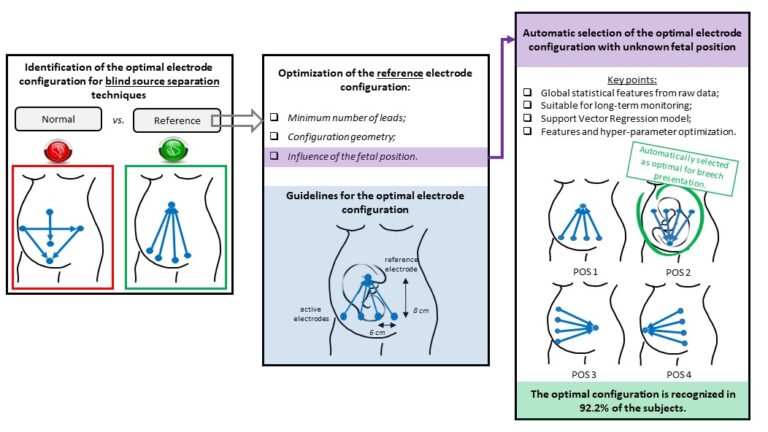Fetal heart rate (fHR) is a key parameter for assessing the fetal condition during pregnancy and delivery, enabling early detection of complications and subsequent timely intervention. Typically, fHR monitoring is performed by cardiotocography (CTG), which is hampered by signal loss due to relative fetal-probe motion and is unsuitable for long-term monitoring. To overcome these limitations, multichannel electrocardiography, typically employing Blind Source Separation (BSS) techniques, has been proposed as a viable alternative. Yet, reliable extraction of the fetal ECG remains challenging due to multiple noise sources and the effects of varying fetal positions.
In this work, we demonstrate that the adopted electrode configuration plays a key role in the effectiveness of BSS and propose guidelines for optimal electrode positioning. To achieve this goal, we compared fHR estimation accuracy with different electrode configurations on in-silico data, identifying the optimal configuration for a recent BSS method. Guidelines for optimal electrode configuration are proposed using a minimum number of leads to facilitate practical implementation for long-term monitoring.
Moreover, a method is proposed to automatically identify the most suited configuration for accurate BSS-based fHR estimation. This method assesses automatically the quality of individual configurations using a support vector regression (SVR) model, which predicts the reliability of the resulting fHR estimation prior to its estimation, based on features extracted from raw signals only. The configuration with the highest quality is then selected.
The assessment of the configuration quality shows 80.9% accuracy; the optimal configuration is recognized in 92.2% of the subjects. The proposed method successfully predicts the quality of the configurations, demonstrating the impact of the electrode configuration on the BSS performance.
The proposed solution, beyond being flexible, robust, and lightweight, can handle the change in the fetal position, ensuring accurate and reliable estimation of the fHR during wearable, long-term monitoring applications.

